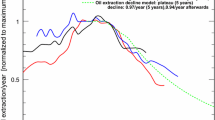Abstract
Following Hubbert’s successful prediction of the timing of US peak oil production, Hubbert’s model has been used extensively to predict peak oil production elsewhere. However, forecasts of world and regional peak oil and natural gas production using Hubbert’s methodology usually have failed, leading to the implicit belief that such predictions always will fail and that we need not worry about finite resources. A careful examination of Hubbert’s approach indicates that the most important reasons for his success in the US were stable markets, the high growth rate of demand, ready availability of low cost imports, and a reasonable estimate of easily extractable reserves. This analysis also shows that his model cannot predict ultimate oil reserves and that it should be considered an econometric model. Building on Hubbert’s vital insight, that cheap fossil fuel reserves are knowable and finite, one can state that for world peak oil production, political constraints should be much more important than resource constraints.
Similar content being viewed by others
References
Adkins, M., 2004, Quoted in Industry Trends: Oil & Gas Jour., v. 102.19, p. 7.
Ahlbrandt, T. (Project Head), 2000, US Geological Survey, world energy resources, world petroleum assessment (2000): Available at http://www.usgs.gov or on CD ROM from the USGS.
API (American Petroleum Institute), 1951, Petroleum facts and figures 1950 (9th edn.): API, New York, p. 117, 490.
Anderson, R. O., 1984, Fundamentals of the petroleum industry: Univ. Oklahoma Press, Norman, OK, p. 23, 235.
Bird, K., and Houseknecht, D., 2001, Arctic national wildlife refuge, 1002 area, petroleum assessment, 1998, including economic analysis: USGS Fact Sheet FS-028–01, Available at http://www.usgs.gov.
Campbell, C., and Laherrere, J., 1998, The end of cheap oil: Scientific American, v. 278, no. 3, p. 78–83.
Cavallo, A., 2002, Predicting the peak in world oil production: Nature Resources Research, v. 11, no. 3, p. 187–195.
Clark, M., 2004, The Bosporus bottleneck: Petroleum Ecnomist, v. 71, no. 6, p. 28.
Deffeyes, K., 2001, Hubbert’s Peak: The impending world oil shortage: Princeton Univ. Press, Princeton, NJ, 224 p.
DOE-EIA (Department of Energy, Energy Information Administration), 2002, US crude oil, natural gas, and natural gas liquids reserves: 2002 Annual Report, DOE/EIA-0216(2002): Washington, DC, 47 p.
DOE-EIA (Department of Energy, Energy Information Administration), 2003, Annual energy preview, DOE/EIA-0384(2002): Washington, DC, 376 p.
DOI-MMS (Department of Interior-Minerals Management Service), 2001, Outer continental shelf petroleum assessment: MMS-2001–036: Washington, DC.
Green, D., Hopson, J., and Li, J., 2003, Running out of and into oil: analyzing global oil depletion and transition through 2050: ORNL/TM-2003/259, Oak Ridge Nat. Lab., Oak Ridge, TN, (http://www.osti.gov/bridge), 103 p.
Hubbert, M.K., 1956, Nuclear energy and fossil fuels: API Conference, San Antonio, TX, (March 7–9, 1956). Later published as Publ. no. 95, Shell Development Co. (June 1956).
Hubbert, M. K., 1962, Energy resources: A report to the Committee on Natural Resources of the NAS-NRC, Publication no. 1000-D, NAS-NRC: Washington, DC, 141 p.
Ivanhoe, L. F., 1995, Future world oil supplies: There is a finite limit: World Oil, v. 216, no. 10, p. 77–88.
Lorenzetti, M., 2004, Saudis refute claims of oil field production declines: Oil & Gas Jour., v. 102.10, p. 24–25.
Maugeri, L., 2004, Oil: never cry wolf—Why the petroleum age is far from over: Science, v. 304, no. 21, p. 1114–1115.
OGJ, 2004, Editorial: Serious about depletion: Oil & Gas Jour., v. 102.32, no. 23, p. 17.
Weaver, J. L., 1986, Unitization of oil and gas fields in Texas: A study of legislative, administrative, and judicial policies: Resources for the Future: Johns Hopkins Univ. Press, Washington, DC, 555 p.
Yergin, D., 1991, The prize: The epic quest for oil, money, and power: Simon and Schuster, New York, p. 536–540.
Author information
Authors and Affiliations
Rights and permissions
About this article
Cite this article
Cavallo, A.J. Hubbert’s petroleum production model: an evaluation and implications for World Oil Production Forecasts. Nat Resour Res 13, 211–221 (2004). https://doi.org/10.1007/s11053-004-0129-2
Received:
Accepted:
Issue Date:
DOI: https://doi.org/10.1007/s11053-004-0129-2




